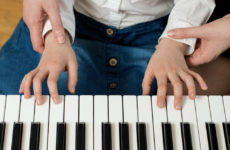
If you’re interested in learning to play the piano, you should first be aware that it’s going to take some time. You can’t just look at it and memorize the location of each of the keys/notes.
Actually taking the time to play the piano is helpful for the application of what you have learned and helps you to understand the keyboard that much more. One of the most important steps in this process is finding and using a good method book.
Use Online Resources
You can find a wealth of online resources- including free online piano lessons– by doing an internet search Go Piano is one such resource. You can find lessons that have letters to indicate the names of the keys on the keyboard.
Once you have reviewed the illustration you find online, its easy to determine the rest of the notes. They are simply a continuation of the pattern- starting with “C” and going up. C-D-E-F-G-A-B-C.
Use Method Books
In addition to using online resources, you’ll want to find and purchase a method book that will help you learn the keyboard. You can find a variety of different ones both at music stores and at your local bookstore.
Print a Piano Keyboard with Keys Labeled
Find a keyboard online that you can print out. You can find one that already has the notes written on the keys or above them or you can write them in yourself.
You can try looking through your method books to see if there’s a keyboard in them and you can write the notes in on it.
Start Playing Scales
A great way to increase your understanding of the keyboard is through playing scales. You should start with a very simple scale, such as C-major.
You will locate middle C and start there, playing 2 octaves only using your right hand. Then, as you progress, you can start playing some of the more complex scales such as G-minor and A-major as your knowledge of piano playing increases.
Practice Arpeggios
Even the beginner piano student can play arpeggios, or broken chords, using the whole keyboard. When you take the time to practice, you get yourself used to playing all octaves and hearing more of the notes than you would if you were only playing a 2-3 octave scale.
Practice Using Both Hands
When you’re just starting out, you’ll want to start with only 1-2 octaves. Then, as you progress in your playing, you’ll start playing 3 or more.
As you get better, you can start using method books that are higher level to assist with development of dexterity and technique.
Play Musical Pieces
You can develop a richer understanding and appreciation of the piano by playing some musical pieces. You should start with simple ones- then, as you get better, you can begin to play pieces that may not necessarily be in your method books. These could be songs that you’d hear on the radio or even at a concert.
Set/Follow a Practice Schedule
When you’re starting a new musical exercise or musical piece, you should start off by playing slowly with a metronome counting your beats. After spending 2 days slowly practicing it, you can gradually speed up the metronome so that you can be able to play the music at the proper tempo when you reach your next lesson.
Make Adjustments to Technique
If you find that you’re having difficulty with learning a particular exercise or musical piece, then you can adjust the metronome technique mentioned above. The slower you practice, the more likely your fingers are to remember where they should go- even if you do rush through playing during a performance due to your nerves.
Many people wonder what is the best keyboard to learn piano. The truth is, if you want to learn piano, then you need to be practicing on a piano. There are too many differences between keyboards and pianos- they are not interchangeable.
You can use these steps/tips to help you become a better piano player in no time. You may want to get a private piano instructor so that you have someone to keep you motivated and help you succeed in learning to play.


